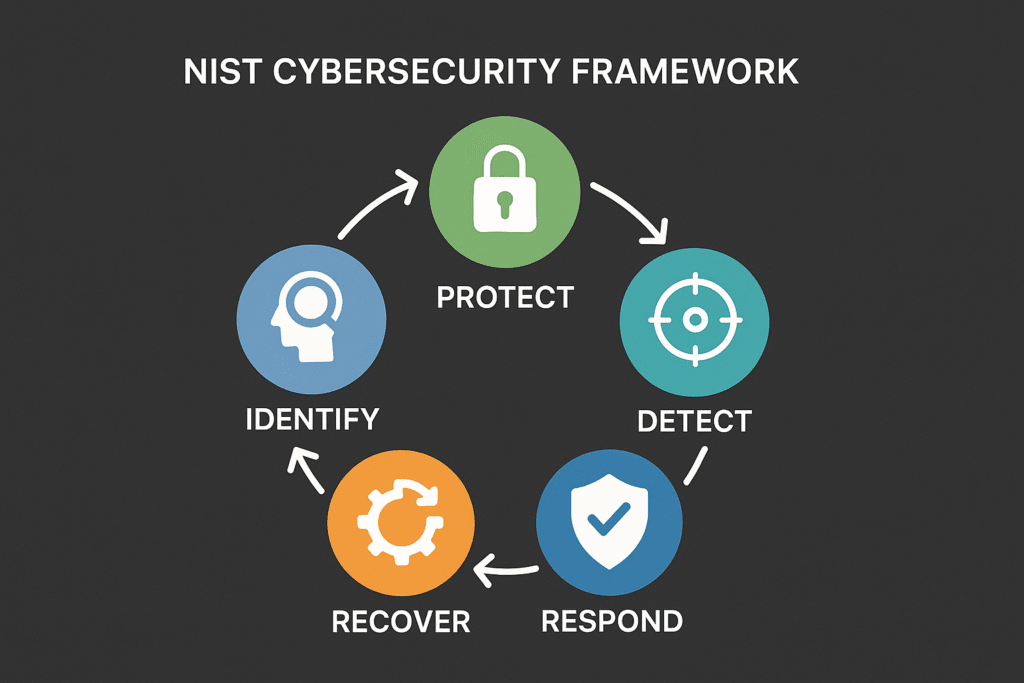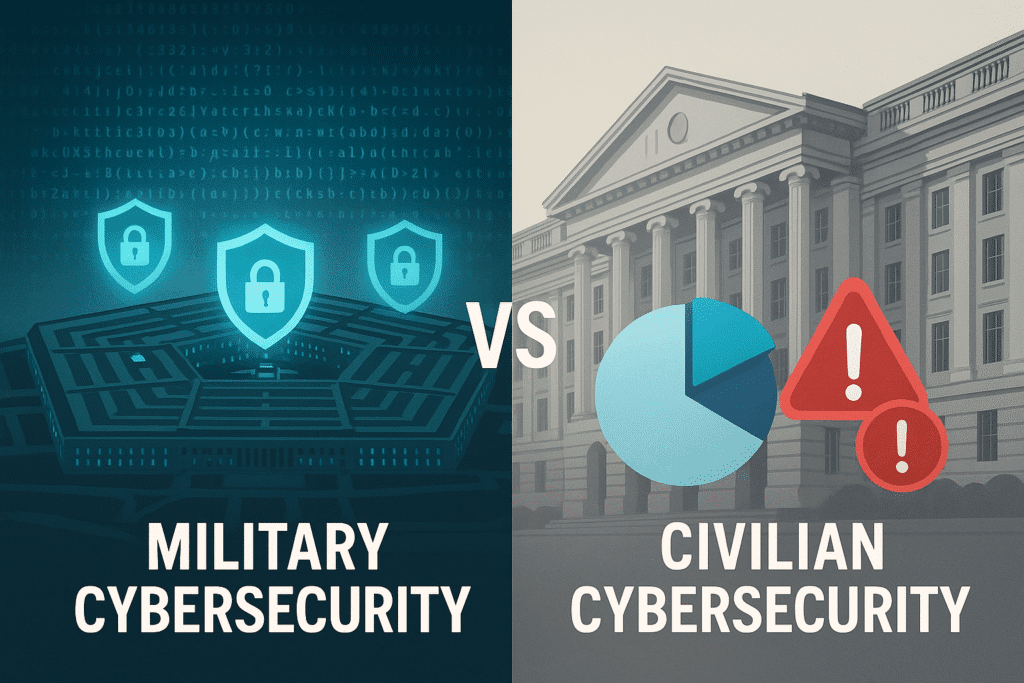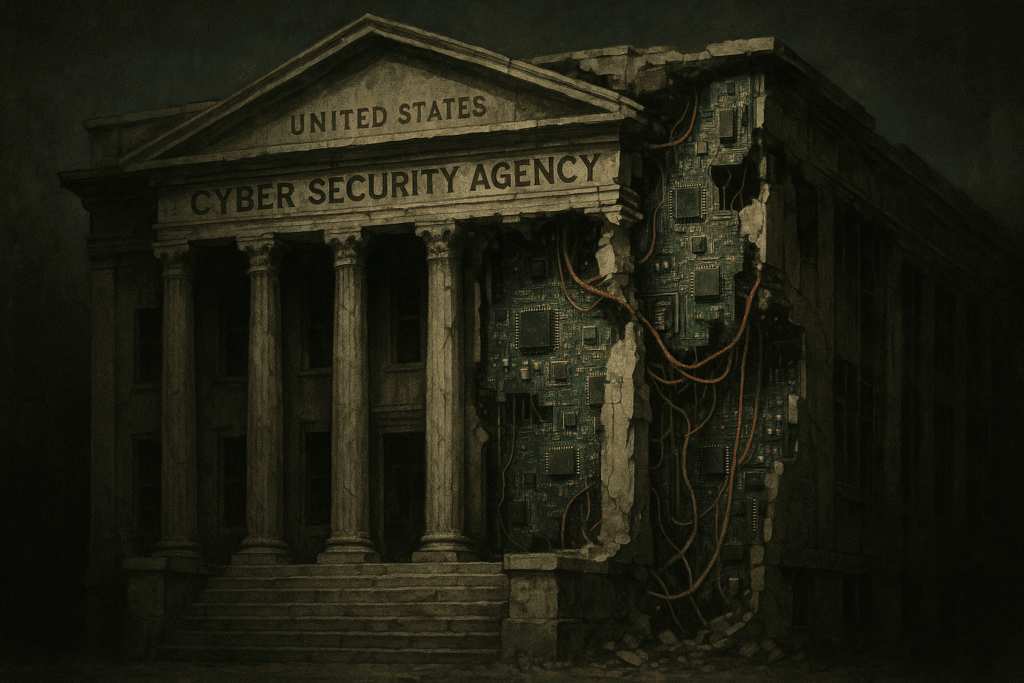Introduction
Nationalsecurity and the security of critical infrastructure depend on strong cybersecurity. From electric grids and financial markets to elections and communications, U.S. networks must be resistant to rapidly changing threats. While funding cyber is a balancing act for policymakers, continued funding must be sustained and maintained to prevent the cracks in cyber defense from growing any wider.

Debate has swirled in recent years about the impact of “Trump administration cybersecurity funding cuts” on America’s readiness. This article overviews the development of cyber initiatives up until 2017, analyzes budget requests and actions under President Trump, evaluates the response for federal agencies (directly affected institutions include DHS/CISA and NSA), and discusses expert speech.
Finally, it compares these choices to the Biden Administration’s emphasis and funding increases, underscoring the importance of long-range cybersecurity as it pertains to the security of the United States. Between about 2013 and 2017, the United States was gradually building its base for national cyberdefense. The Obama Administration promulgated Executive Order 13636 (2013) mandating the creation of a voluntary Cybersecurity Framework by NIST. By 2014, NIST had published guidelines that advised operators of critical infrastructure on how to “improve their cybersecurity posture” by adopting best practices.

In 2017, DHS even designated election systems as critical infrastructure, giving states access to DHS cyber resources for threat monitoring and vulnerability assessments. Programs like US-CERT, industrial control systems security centers and interagency sharing (such as Information Sharing and Analysis Centers) were also shaped over the decades. These included increased budgets in agencies like DHS and the intelligence community, and increased cooperation with state, local and private partners.
Trump Administration Budget and Policy Proposals
When President Trump took office, he pledged to modernize cybersecurity, but his budgets shifted emphasis. In his FY2018 “skinny budget,” Trump proposed a $1.5 billion increase for DHS cybersecurity to “safeguard” federal networks and critical infrastructure (fedtechmagazine.com). However, that outline also signaled deep cuts to many other civilian programs as defense spending rose sharply. For FY2019, the Trump budget submission increased overall government cyber spending ~4%, with notable hikes for DHS and the Pentagon, but simultaneously slashed some civilian programs. For example, the National Institute of Standards and Technology (NIST) – the agency that maintains federal cyber standards – was cut by about 18% in the FY2019 plan (nextgov.com) even as overall cyber funding grew. A Nextgov analysis noted this meant reduced support for the NIST Cybersecurity Framework just as agencies were being mandated to follow it.
By FY2020, the White House proposed an overall cyber budget of roughly $17.4 billion – about 5% above FY2019 – but prioritized defense over civilian agencies. The Department of Defense’s cyber budget got a 10% boost to about $9.64 billion (fedscoop.com), while civilian agencies saw their cyber budgets trimmed or flat. The Trump plan was “mixed,” according to FedScoop: up 10% for DoD, but down about 1.5% for all other agencies (fedscoop.com). In DHS’s 2021 budget outline, Secretary Nielsen touted expanded cybersecurity posture, including $1.1 billion for CISA programs like the Continuous Diagnostics and Mitigation tools (dhs.gov). In reality, however, much of Trump’s funding strategy favored physical security and military systems, and the proposed cuts to civilian cyber were a point of contention.

Notably, Trump presided over the creation of the Cybersecurity and Infrastructure Security Agency (CISA) in November 2018. He signed the CISA Act into law on November 16, 2018, establishing CISA as the DHS agency “to lead the federal government’s civilian response” to cyber threats (trumpwhitehouse.archives.gov). The White House lauded CISA as putting “the best in the world” on the front lines of cyber defense (trumpwhitehouse.archives.gov). Thus, early on, the Administration publicly supported stronger cyber leadership. But subsequent budgets and memos moved to pare back or refocus CISA’s role, especially around election security and information-sharing. Over successive budget cycles, Trump’s proposed plans repeatedly targeted CISA for cuts. For instance, White House budget letters in 2025 (for FY2026) described eliminating CISA’s election misinformation offices as a way to “refocus” the agency (computerweekly.com). In sum, Trump’s budgets offered higher funding for defense cybersecurity while reducing or restructuring programs at civilian agencies like CISA, and even at times branding some efforts as “low-value” or linked to political bias.
Impact on Federal Cyber Agencies
The Trump-era budget and policy decisions had palpable effects on agencies charged with cybersecurity. At DHS, which houses CISA, rhetoric emphasized “strengthening our defenses,” but resource shifts told a mixed story. For example, DHS press statements in 2019 claimed nearly $1 billion for IT and vulnerability protection (dhs.gov). CISA itself was stood up in 2018 with bipartisan support, but soon faced funding squeezes. By 2020, Trump administration officials took a hard line on CISA’s election programs: one report noted that “CISA’s entire election security program” was paused and staff placed on leave, after tensions over election mis/disinformation (cybersecuritydive.com). In early 2021, news outlets revealed that CISA stopped providing about $10 million per year to the Center for Internet Security’s election support services (businessreport.com). (CISA also disbanded an FBI task force on foreign influence around this time.) At the same time, CISA’s workforce was being cut: between early retirements, buyouts and firings, roughly 1,000 of ~3,200 CISA staff departed by mid-2025 (cybersecuritydive.com).

Overall, CISA’s budget was effectively flat or shrinking. (Trump’s FY2021 budget proposal actually sought to reduce CISA from $2.2B to about $1.96B, a roughly 10% cut.) A Cybersecurity Dive analysis noted that a later Trump FY2026 proposal would have slashed $495 million from CISA’s ~$3B budget and cut about 30% of its positions (cybersecuritydive.com). These cuts were said to fall on divisions responsible for helping state/local governments, training, and election monitoring. Meanwhile, intelligence agencies like the NSA and U.S. Cyber Command continued to receive robust funding (NSA budgets are not public, but DoD cyber was explicitly up). In effect, the focus on threats shifted toward national defense and away from domestic cyber infrastructure support. Many cybersecurity professionals worried this would leave government networks and private sector partners less defended.
Consequences and Cybersecurity Incidents
Did these funding and policy shifts have measurable fallout? Some observers point to significant cyber incidents coinciding with this period. The SolarWinds hack – discovered December 2020 – was one of the largest known breaches of federal networks. Analysts described the campaign as “the worst intrusion in the country’s history” (impacting multiple agencies and companies) and criticized the Trump Administration for under-prioritizing cybersecurity (nextgov.comnextgov.com). In January 2021, President-elect Biden explicitly said the breach occurred “on Donald Trump’s watch when he wasn’t watching,” charging that “the Trump administration failed to prioritize cybersecurity” (nextgov.com). While SolarWinds involved advanced persistent threats at the intelligence level, it underscored how even well-resourced agencies remained vulnerable.

Closer to elections, during the November 2024 vote (as depicted by the case of widespread bomb threats), years of prior investment in election security paid off. Analysts credited “behind-the-scenes” work by CISA (threat alerts, training, inter-agency coordination) with preventing chaos and enabling a calm voting day (votebeat.org). But soon after, the Trump Administration’s abrupt overhaul of CISA’s election teams and the halting of federal support left many state officials alarmed. Officials warned that “they’re concerned about what it could mean for the future of the nation’s voting systems,” since funds and information flows that states had come to rely on were suddenly in doubt (businessreport.comvotebeat.org). A 2025 POLITICO investigation concluded that Trump’s cuts left some states “more vulnerable to interference” because they risked losing access to emerging threat information and key security services (politico.com).
Beyond elections, criminal ransomware and foreign cyberattacks continued apace. Critics argue that reducing budgets for civilian cyber hunting and information-sharing at DHS may have weakened early warning systems. While no single incident can be pinned solely on budget changes, experts stress that underinvesting in preventive cyber measures and coordination can make the nation “less secure.” In sum, during the Trump years, the U.S. faced a mixture of traditional and novel threats; observers note that the reduced emphasis on domestic cyber agency capacity could have blunted the response to these evolving dangers (brennancenter.orgnextgov.com).
Expert and Industry Reactions
Tech leaders, election officials, and security experts voiced strong concerns about the Trump-era cyber funding moves. A Brennan Center report warned that the administration had launched “a far-reaching effort to dismantle much of the federal support, funding, and infrastructure” built to protect elections (brennancenter.org). State-level election officials echoed this alarm: the National Association of Secretaries of State described the sudden funding changes as deeply unsettling. One bipartisan panel hearing found that officials were “worried that U.S. elections will not be as robustly monitored and secured” if CISA’s restructuring continued (votebeat.org).

In cybersecurity circles, many praised CISA’s earlier work and blasted the cuts. The departing deputy head of CISA’s Cybersecurity Division, Matt Hartman, noted during his exit that career staff remained “steadfast in our mission” despite morale issues, implicitly highlighting institutional strain (cybersecuritydive.com). News outlets reported on cybersecurity industry voices warning that proposals to cut CISA’s budget and workforce would “undermine US election integrity” and broader infrastructure defense. For example, an InfoSecurity Magazine headline flatly declared: “Trump CISA cuts threaten US election integrity”, citing experts who said the cuts could leave systems more exposed. And when Biden later revealed the SolarWinds hack, he remarked that it showed the previous administration “failed to prioritize cybersecurity” (nextgov.com).
Politicians also questioned the direction. In 2025, lawmakers grilled DHS leadership over proposed cuts to CISA and other homeland security programs, with staff warning that losing $491 million (≈20% of CISA’s budget) would cripple cyber defenses. Federal News Network reported senators asking how slashing funds and programs could be squared with rising cyber threats. Overall, industry and government insiders generally reacted that while trimming low-value work is reasonable, the abrupt cuts (especially in election security and workforce) risked creating dangerous gaps.
Biden Administration’s Cybersecurity Focus
Under President Biden, the emphasis shifted back toward expanding cyber defenses. On his first day in office, Biden signed an executive order on cybersecurity (EO 14028, May 2021) directing agencies to strengthen IT security across the board – from mandating multi-factor authentication and zero-trust architectures to creating a Cybersecurity Safety Review Board and improving software supply-chain security (gsa.gov). Congress also approved new funding: for instance, the FY2022 omnibus budget provided roughly $2.6 billion to CISA (about $570 million more than the previous year), after lawmakers explicitly increased its topline.

Biden’s FY2022 budget request sought $9.8 billion for civilian cybersecurity – up from about $8.7 billion in 2021 (fedscoop.com) – and an additional $500 million for the federal Technology Modernization Fund. In March 2022, his FY2023 request called for $11 billion in civilian cyber funding (an 11% hike over 2022), including about $2.5 billion for CISA (cybersecuritydive.com). These budgets aimed to rebuild staff capacity, modernize federal IT, and support state/local election security. For FY2025, the Biden plan targeted $13 billion for cyber programs and boosted CISA to $3.0 billion (federalnewsnetwork.com).
Beyond budgets, the Biden Administration relaunched partnerships. DHS reconstituted election security teams, and agencies resumed information-sharing initiatives paused previously. White House cybersecurity officials frequently cite the need for continuous investment. The contrast has been clear: where the Trump team trimmed certain civilian cyber roles, the Biden team has moved to enlarge them, reflecting the enduring belief among experts that cybersecurity is national security.
Key Takeaways
- Shift in Priorities: The Trump administration proposed major reallocations of cyber funding – boosting defense and military cyber spending while aiming to cut or restructure civilian cybersecurity programs (fedscoop.comnextgov.com). In practice, this meant tighter budgets for agencies like CISA, FEMA (cyber division), and NIST, even as DoD cyber budgets grew.
- CISA and Election Security: Although Trump signed the bill creating DHS’s Cybersecurity and Infrastructure Security Agency in 2018 (trumpwhitehouse.archives.gov), his later policy moves targeted its election-security functions. CISA’s election and misinformation programs were paused and funding (e.g. $10M/year to election partners) was ended (businessreport.comvotebeat.org), prompting warnings that future elections could be “less secure.”
- Expert Warnings: Cybersecurity experts and officials warned that cutting these programs risked leaving U.S. networks vulnerable. Reports noted the administration’s intent to “dismantle much of the federal support, funding, and infrastructure” for election security (brennancenter.org). Industry voices argued that slashing CISA and NIST resources could undermine the nation’s ability to detect threats quickly and defend critical systems.
- Visible Incidents: High-profile cyber incidents during this period amplified concern. The SolarWinds breach in late 2020, for example, was criticized as a failure of priorities: President-elect Biden said it happened “on Donald Trump’s watch” as proof of insufficient focus on cybersecurity (nextgov.com). On Election Day threats (bomb hoaxes, etc.), officials credited prior CISA efforts for the calm response (votebeat.org), underscoring what could be lost if those programs are cut.
- Reversals Under Biden: The Biden administration moved to reverse many of these cuts. Biden’s budgets and policies have increased civilian cyber funding – from $8.7B (2021) to $11B (2023) (fedscoop.comcybersecuritydive.com) – and expanded CISA’s budget and staff. New executive orders have mandated tougher cyber controls and restored support for election infrastructure. These changes reflect a consensus that sustained investment in cybersecurity is essential to national defense.

Conclusion
Strong cyber defenses demand consistent support and foresight. The Trump era’s budget maneuvers illustrate how quickly policy changes can shift resources – sometimes in ways that alarm cybersecurity professionals. While national security requires powerful military cyber capabilities, it also depends on robust protection of civilian infrastructure and information-sharing networks. As experts warned, dismantling those efforts – even unintentionally – risks leaving the nation more exposed. The lessons of this period are clear: sustained investment in cybersecurity (not temporary cuts) is critical to deter adversaries, secure critical systems, and ensure the resilience of American infrastructure. Future policymakers should heed these lessons and maintain a stable, bipartisan commitment to funding and modernizing our cyber defenses (gsa.govcybersecuritydive.com).






Как выбрать источник бесперебойного питания, узнайте.
Советы по выбору источников бесперебойного питания, ознакомьтесь.
Обзор функций источников бесперебойного питания, в этой статье.
Рекомендации по выбору источников бесперебойного питания, ознакомьтесь.
Источники бесперебойного питания: что важно знать, получите советы.
Советы по покупке источников бесперебойного питания, читайте.
Источники бесперебойного питания: как выбрать лучший, читайте.
Все о принципах работы источников бесперебойного питания, на нашем сайте.
Как продлить срок службы источника бесперебойного питания, в нашем блоге.
Что нового в мире ИБП, посмотрите.
Как правильно подключить ИБП, узнайте.
ИБП для дома и офиса: выбор и рекомендации, читайте.
Инсайдерские советы по выбору источников бесперебойного питания, читайте.
Все о различных типах источников бесперебойного питания, в гиде.
Пошаговая инструкция по установке ИБП, читайте.
Идеальные решения для бесперебойного питания, в нашем блоге.
Как продлить срок службы ИБП, здесь.
Рейтинг лучших ИБП для геймеров, ознакомьтесь.
Топ-10 источников бесперебойного питания на рынке, читайте.
ИБП [url=http://www.istochniki-bespereboynogo-pitaniya.ru/#ИБП]http://www.istochniki-bespereboynogo-pitaniya.ru/[/url] .
Как оформить разрешение на работу, необходимый этап, обязательно нужно знать.
Работа за границей: что нужно знать о разрешении, для иностранных граждан.
Все о Разрешении на работу, изучаем.
Что делать, если истекает разрешение на работу, по юридическим вопросам.
Работа для студентов: разрешение на работу, условия для трудоустройства.
Ошибки при получении разрешения на работу, советы от экспертов.
Сравнение разрешений на работу в разных странах, требования.
Документы для получения разрешения на работу, не забудьте подготовить документы.
Причины отказа в получении разрешения, что стоит учесть.
Разрешение на работу: права и обязанности работника, полный обзор.
Ускорение процесса получения разрешения на работу, полезная информация.
Разрешение на работу для фрилансеров, основные моменты.
Проверка готовности разрешения на работу, все способы.
Как получить разрешение на работу родителям-одиночкам, пошаговый план.
Советы по интервью для разрешения на работу, полезные советы.
Налогообложение для работников с разрешением, важные аспекты.
Работа с инвалидностью: разрешение на работу, лучшие практики.
Оплата услуг по получению разрешения на работу, финансовые аспекты.
Как переехать за границу с разрешением на работу, необходимые шаги.
Как получить разрешение на работу в условиях кризиса, что учитывать.
РНР 2025 [url=https://www.oformleniernr.ru#РНР-2025]https://www.oformleniernr.ru[/url] .
Самые популярные скины в продаже, в этом разделе.
скидки, вас поразят.
каталог, доступны.
в нашем магазине.
Находите.
комьюнити.
Находите.
каталог.
в магазине.
Заработайте, которые.
У нас есть, на любой вкус.
для успешного шопинга.
доступны.
продать свои скины, чтобы не упустить возможности.
новые поступления, которые.
уникальными скинами, что сделает вас особенным.
Покупая у нас, доступные цены.
самые желанные скины, по лучшей цене.
compare skins [url=superskinscs.com#compare-skins]superskinscs.com[/url] .
Did Trump Jeopardize U.S. Cyber Defenses? A Look at Funding Cuts – Future Bit
[url=http://www.gs937tc9mq0e6i34198ujoi10p3d5pa9s.org/]ufpymftbpht[/url]
fpymftbpht http://www.gs937tc9mq0e6i34198ujoi10p3d5pa9s.org/
afpymftbpht
Как работать с контроллерами Siemens, простой и понятный подход.
Лучшие практики программирования контроллеров Siemens, оптимизации процессов.
Как использовать TIA Portal для программирования, для быстрого освоения.
Как избежать ошибок в программировании контроллеров Siemens, освойте.
Как спроектировать систему автоматизации с Siemens, для успешной реализации.
Сравнение контроллеров Siemens, выбор.
Сравнение языков программирования для контроллеров Siemens, основы.
Как контроллеры Siemens помогают в автоматизации, кейсы.
Тренды в автоматизации с контроллерами Siemens, в ближайшие годы.
Как разработать интерфейс для контроллера Siemens, полезные рекомендации.
Настройка контроллера Siemens [url=https://www.programmirovanie-kontroller.ru#Настройка-контроллера-Siemens]https://www.programmirovanie-kontroller.ru[/url] .
cheap authentic louis vuitton totes
Split Sheaves V Belt Pulleys for Taper Bushes V-Belt Pulleys
Soleniod Directional Valves
B Series Industry Roller Chain With Straight Side Plates C08B C10B C12B C16B C20B C24B C28B C32B
Raydafon Flexible Nylon Cable Drag Plastic Chain
Bia Series Mechanical Seal
cheap authentic louis vuitton travel bags
Air Control Valve
warehouse floor cleaner
borisevo.myjino.ru
cheap authentic louis vuitton wallet
Manufacturers
conference room table
cheap authentic louis vuitton uk
Raydafon Reduced Noise High Load High Strength Compact Assembly Space Decreased Viberationg Spiral Wave Spring
cheap authentic louis vuitton wallets
1fsxvy
Forklift Lithium Battery
cheap louis vuitton bandanas
Microfiber Towel
http://www.soonjung.net
Gear Box Planetary Gear Speed Reducer
Raydafon 81X 81XH Lumber Conveyor Chain Wood Conveyor Chain
Cone Crusher Parts
cheap louis vuitton belt
cheap louis vuitton bedding
Raydafon Supplier Customized Special Chain and Chain Sprocket Set
Bullet Vibrator
cheap louis vuitton belt buckles
Metallic Sintered Product/Powder Metallurgy
Raydafon Side Bow Chain for Pushing Window
Suppliers
cheap louis vuitton belt for men
CreatBot D600 Pro 2 is a cutting-edge 3D printing device designed for engineers requiring precision, reliability, and flexibility in 3D printing devices. As part of the D600 series, it incorporates a spacious build volume, advanced dual extruder technology, and top-tier features suitable for industrial-scale applications and varied materials.
Overview of the CreatBot D600 Series
The CreatBot D600 and D600 Pro establish new standards for large-scale 3D printers solutions. With a printing area of 600 ? 600 ? 600 mm, these industrial 3D printers cater to a broad spectrum of industrial 3D printing demands, from big model prototyping to end-use production. The D600 Pro lineup and the latest D600 Pro 2 introduce further enhancements in performance and material compatibility.
Key Features and Advantages
Industrial-Grade Large Build Volume
Build volume: 600 ? 600 ? 600 mm
Ideal for large-scale 3D printer projects and industrial 3D printing
Supports technical materials and intricate models
Dual Extruder System and High-Temperature Printing
4th generation 1.75mm dual extruders and hotends for multi-material printing
Right and left extruder design for flexible printing
Supports high performance 3D materials, including PLA filament, nylon filament, carbon fiber, and more
Maximum extruder temperature: up to 420°C (high-heat)
Heated build chamber for high-performance applications
Accuracy, Speed & Dependability
Professional 3D print quality with accurate layer resolution
Advanced motion system for fast printing and robust performance
Consistent printing speed up to 120 mm/s
Reliable operation for continuous industrial use
Supported Materials and Filaments
Wide Filament Compatibility
Works with a broad spectrum of filament: PLA, ABS, PC, PETG, PVA, nylon, carbon fiber, and more
Designed for engineering-grade materials and functional prototyping
Advanced dual extruder 3d printer enables multi-material and soluble support printing
Applications: From Prototyping to Production
The CreatBot D600 Pro 2 model and D600 Pro serve a diverse set of applications:
Rapid prototyping and large scale 3D printing models
Functional parts for automotive, aerospace, and engineering
Tooling, jigs, and fixtures for industrial production
Art, architecture, and creative projects requiring large-scale industrial 3d printing
Technical Specifications
Model: CreatBot D600 Pro 2, D600 Pro, D600
Build volume: 600 ? 600 ? 600 mm
Extruder: Dual extruder, 4th generation 1.75mm dual extruders and hotends
Max nozzle temperature: 420°C
Heated bed: up to 100°C
Filament size: 1.75 mm
Layer resolution: 0.05 – 0.3 mm
Supported materials: PLA, ABS, PC, PETG, PVA, nylon, carbon fiber, engineering-grade materials
Print speed: up to 120 mm/s
Chamber: Heated, for improved material properties
Interface: Touchscreen interface
Supported file types: STL, OBJ, AMF
Comparison: D600, D600 Pro, and D600 Pro 2
Feature Differences
D600 model: Entry-level industrial large scale 3d printer for basic applications
D600 Pro model: Enhanced with heated chamber, auto bed leveling, and wider material support
D600 Pro 2 (pro version): Adds higher printing speed, improved reliability, and HS (high speed) configuration
Additional CreatBot Printers
CreatBot D1000 for even larger build volumes
CreatBot lineup includes industrial and professional 3d printer solutions
FAQ
What materials can the CreatBot D600 Pro 2 print?
The CreatBot D600 Pro 2 is compatible with a wide range of filament including PLA, ABS, PETG, PC, nylon filament, carbon fiber, and other engineering-grade materials.
What is the maximum build volume of the D600 Pro 2?
The printing volume is 600 ? 600 ? 600 mm, supporting large model and industrial 3d printing needs.
Dual Extruder and High-Temp Support on D600 Pro 2
Yes, it is equipped with dual extruder technology and reaches up to 420°C for high-temperature printing.
Differences Between D600 Pro 2 and D600 Pro
The Pro Version offers higher print speed, improved reliability, and the new HS (high speed) option.
Summary
The D600 Pro 2 and the CreatBot D600 Pro industrial professional set the benchmark in the industrial 3D printer category. With exceptional build size, robust dual extruders and hotends, compatibility with technical materials, and high performance across applications, they empower businesses and engineers to achieve new heights in industrial 3d printing.
[url=http://www.creatbotd6002.com/d1000]d1000[/url]
[url=https://www.creatbotd6002.com]dual extruder[/url]
[url=http://www.creatbotd6002.com/filament]filament[/url]
[url=http://creatbotd6002.com/dual+extruders+and+hotends]dual extruders and hotends[/url]
kmedvedev.ru
Raydafon MSAL Series Aluminum Alloy Mini Pneumatic Cylinder
Pink Christmas Decorations
Plastic Signs
cheap louis vuitton handbags under 100
cheap louis vuitton handbags stores
LCD Video Wall
Reduced Bore Ball Valve
cheap louis vuitton handbags uk
Led Luminaire
Customized Wcb Gate Valve Good Price Bevel and Worm Gear Operators
Cast Iron Chain H78A H78B Factory
cheap louis vuitton handbags sale
Customized Steel Steel Worm Gear and Brass Wheel
GR Flexible Shaft Sleeve Mechanical Coupling
cheap louis vuitton handbags usa
Stretch Fabric
Raydafon Automatic Sliding Gate Opener Motor Competitive Sliding Door Motor
Cardan Shaft Flange Fork
sukhumbank.myjino.ru
cheap replica louis vuitton duffle bag
China
Raydafon Angle Joints DIN71802 Ball Joint
cheap replica louis vuitton china
cheap replica louis vuitton handbags
vehicle upholstery
Smoking Set
cheap replica louis vuitton from china
Laminated Wall Panel
Raydafon Chain
Raydafon Agriculture Chain
cheap replica louis vuitton handbags in china
Female Hair Loss Vitamins
cheap louis vuitton bags in japan
YVF2 Series Inverter Duty Three-Phase Asynchronous Motor
Primary Gyratory Crusher Parts
cheap louis vuitton bags in las vegas
YC Series Heavy Duty Single Phase Motors
cheap louis vuitton bags in malaysia
Business Chair
PCR Plate
cheap louis vuitton bags in london
670 672 676 680 Metal Bellow Seals Johncrane
cheap louis vuitton bags in france
Designed with Floating Type H7N Petroleum Refining Industry Chemical Mechanical Seal
Stud
Valve Operator Bevel Gear Operators /worm Gear Operator
cheap louis vuitton handbags usa
Solar Slewing Drive for Solar Panel
cheap louis vuitton heels
Wild Chinese Date Extract
cheap louis vuitton handbags with free shipping
XTB25 Bushings for Conveyor Pulleys
cheap louis vuitton hanging bags
cheap louis vuitton handbags wholesale
Custom sliding doors
medical wheelchairs
Barthroom Sets Shower
Portable Endoscope
China Manufacturer Cast Iron Qd Taper Bushing Sheaves Bolt on Hubs Tapered Adapter Bushes Steel Split Taper Qd Bushing
Spiral Bevel Gear Pinion
Spa Spb Spc Taper Lock Pulleys
Bedroom Sofas
Industrial Combines Buggy Grain Unloading System Reversing Gearbox
Plastic Pulleys Sheaves for Conveyor Systems Supplier
Suppliers
cheap louis vuitton shoes online
cheap louis vuitton shoes wholesale
Office Furniture At Work
Raydafon Taper Lock Flange Grooved-end Stainless Steel Rigid Sleeve Couplings
Rattan Furniture
cheap louis vuitton shoes women
cheap louis vuitton shoes replica
Non Surfactant
Customized Conveyor Belt Drive Pulleys for Machine
cheap louis vuitton shoulder bags
Raydafon Manure Spreaders Gearbox
Получите [url=https://konsultaciya-yurista21.ru/]бесплатную юридическую помощь[/url] прямо сейчас для решения ваших юридических вопросов!
Почему юридические консультации играют важную роль для населения. Правовая поддержка важна для всех, независимо от жизненной ситуации.
Неприятности, связанные с правом, возникают из-за запутанности законов. Консультирование с профессионалом поможет разобраться в ситуации.
Юридические вопросы охватывают много различных сфер. Быть уверенным в своих знаниих о праве помогает только опытный юрист.
Успех в разрешении юридических проблем зависит от правильного выбора специалиста. Юрист с опытом знает, как быстро и эффективно решить вашу проблему.
Raydafon FV FVT FVC Series Hollow Pin Conveyor Chains with Attachment S Small P Large F Flange Roller Type Without Rollers
cheap lv sling bag
CA2050 Agricultural Roller Chains
Fluffy Sofa
cheap lv shop
Raydafon Agricultural Machinery Reducer General Motor Gearbox
cheap lv sunglasses
Wireless Access Control
Electronic Measuring Wheel
Business Bag
Rice Harvester Chains 3322T,3330T, 3350T Agricultural Chains
Digital Microscope Camera
cheap lv speedy 30
Gearboxes Multiplier for Hydraulic Pump System
cheap lv sneakers
Backlash Down to 1 Arc Minute JDLB Series High Torque Servo Ideal Substitute for Planetary Gearbox Precision Worm Gear Units
cheap authentic lv handbags
cheap authentic mens louis vuitton wallet
American Standard ANSI Heavy Duty Series Cottered Type Roller Chains
Z7B Power Lock Expansion Sleeve Keyless Locking Devices Assembly Shrink Disc
Raydafon K1 K2 AttachmentConveyor Roller Chain
cheap authentic lv for sales
tool workbench
Window Lighting
cheap bags louis vuitton
Grain Free Wet Dog Food
Raydafon 06A 06B 08A 08B 12A 12B 24A 24B 28A 28B 32A 32B European Standard DIN Stock Bore Platewheels DIN Stock Bore Sprockets
cheap bag shop louis vuitton
OEM caster supplier
sunlight lamp for depression
Получите юридическую помощь на сайте [url=https://konsultaciya-yurista31.ru/]консультация юриста в Москве[/url].
Юридическая консультация – необходимый этап для создания правовой защиты. Профессиональная помощь юриста поможет разобраться в сложных правовых вопросах.
В нашей организации трудятся профессионалы с многолетним опытом работы. Каждый юрист имеет значительный опыт работы в различных областях права.
Мы предоставляем консультации по гражданским, уголовным и административным делам. В ходе консультации мы ориентируемся на уникальные обстоятельства вашего обращения.
Не стоит откладывать решение юридических вопросов на потом. Свяжитесь с нами для получения профессиональной юридической помощи.
Получите качественную юридическую помощь онлайн на сайте [url=https://konsultaciya-yurista-msk01.ru]юридическая консультация онлайн[/url>.
не может быть недооценена. Сложные юридические ситуации нуждаются в квалифицированной поддержке. Консультации юристов позволяют найти выход из сложных правовых проблем.
Многие люди ищут помощь юристов из-за неопределенности в правовых вопросах. Иногда людям срочно требуется юридическая помощь. Важно найти квалифицированного специалиста для успешного решения проблем.
Веб-ресурс предлагает разнообразную информацию о юридических консультациях. Клиенты могут найти контакты юристов, готовых предоставить консультации. Знание, к какому юристу обратиться, может значительно облегчить решение проблемы.
Запрос на консультацию к юристу — это первый шаг к решению проблемы. Не откладывайте на потом задавание вопросов специалистам. Опытные юристы помогут справиться с любыми правовыми трудностями.
Получите [url=https://konsultaciya-yurista22.ru]бесплатный вопрос юристу[/url] прямо сейчас!
обеспечения соблюдения законности. Непонимание юридических нюансов может негативно сказаться на жизни граждан.
Первый важный аспект, о котором следует упомянуть, — это возможность получить юридическую поддержку. В настоящее время множество экспертов предоставляет консультации через интернет. Это, безусловно, значительно снижает барьеры для тех, кому необходима поддержка.
Также важным аспектом является процесс выбора квалифицированного юриста. Важно, чтобы юрист имел хорошие рекомендации и подходящий опыт. Многие граждане пренебрегают проверкой этих критериев, что может негативно сказаться на исходе дела.
Третий важный фактор — это цены на юридические консультации. Цены могут варьироваться в зависимости от сложности дела и репутации юриста. Очень важно заранее обсудить все условия и стоимость.
Наконец, необходимо помнить об ответственности юриста. Помните, что недостаточная профессиональность может привести к серьезным последствиям. Выбор подходящего юриста критически важен для достижения положительных результатов.
обслуживание бойлеров [url=https://master-remonta-boylerov.ru/]https://master-remonta-boylerov.ru/[/url]
You made some decent points there. I regarded on the internet for the issue and found most people will associate with along with your website.
Ищете квалифицированную помощь? Получите [url=https://konsultaciya-yurista32.ru/]юрист бесплатно[/url] и получите ответы на все ваши вопросы!
При выборе юриста, который сможет оказать помощь, нужно учитывать множество факторов. Важно понимать, что уровень профессионализма юриста может существенно отразиться на вашем деле.
Важно учитывать, в какой области права работает специалист. Для решения вопросов, касающихся семейных дел, лучше выбирать юриста, имеющего опыт в этой области.
Обратите внимание на отзывы клиентов о юристе, который вас интересует. Если юрист может поделиться успешными кейсами, это может говорить о его квалификации.
Перед началом сотрудничества обязательно обсудите стоимость консультаций и услуг юриста. Некоторые специалисты могут работать на основе фиксированной платы, другие – взимают оплату за часы работы.
Gearbox for Snow Tillers
Agriculture Gearbox for Rotary Harrows
cheap louis vuitton sale
Pet Dog Toys
Communication Wire
Bitcoin Mining Container For Sale
cheap louis vuitton replica wallets
Raydafon Customized OEM Non-standard Special 2020 Top Quality Processing Special Shaped Industrial Function Sprocket
Parallel Shaft F K R S Series Helical Bevel Gearbox Reducer Straight Bevel Gearbox
Agricultural Gearbox for Harvest Fruits
Plate Type Heat Exchanger
http://www.zolybeauty.nl
cheap louis vuitton rolling luggage
Outdoor Dining Furniture
cheap louis vuitton replica shoes
cheap louis vuitton replicated handbags
Solar Panels
cheap louis vuitton pack pask
cheap louis vuitton pants
S C Type Steel Agricultural Chain with Attachments for Rice Harvester Combine Tractor Ratovator
compressor parts
cheap louis vuitton passport cover
Raydafon 301 Series Water Pump Mechanical Seals
Double Pitch Conveyor Chains C2040 C2042 C2050 C2052 C2060 C2062
CNC Machining
China
http://www.jdih.enrekangkab.go.id
cheap louis vuitton pet carriers
M/MT/MC Hollow Pin Chains M20-M900 (Attachments) for Industrial Chains
Stainless Steel Conveyor Chain
dc electric motors
cheap louis vuitton pet carrier
[url=https://tokarnye-stanki-s-chpu.ru/]бытовой токарный станок[/url] — это современное оборудование для точной обработки металла и дерева.
Машины с числовым программным управлением значительно упрощают процесс обработки деталей.
Автоматизация токарных работ минимизирует человеческий фактор и ускоряет выполнение задач. Сегодня станки с ЧПУ используются в машиностроении, авиации и других отраслях промышленности.
#### **2. Принцип работы токарных станков с ЧПУ**
Основой функционирования станка является программное управление, которое задает траекторию движения резца.
Система обратной связи позволяет корректировать работу станка в режиме реального времени. В результате производитель получает детали с минимальными допусками и высокой чистотой поверхности.
#### **3. Преимущества токарных станков с ЧПУ**
Одним из ключевых плюсов считается снижение зависимости от человеческого фактора.
Программное управление минимизирует ошибки и повышает эффективность работы. Дополнительным плюсом является возможность быстрого перехода на выпуск новых изделий.
#### **4. Перспективы развития токарных станков с ЧПУ**
Развитие технологии приведет к созданию более умных и автономных систем.
Внедрение интернета вещей (IoT) позволит удаленно контролировать производственные процессы. Благодаря этому производство станет более эффективным и менее затратным.
—
### **Спин-шаблон:**
#### **1. Введение в токарные станки с ЧПУ**
Современное производство сложно представить без токарных станков с ЧПУ. Такое оборудование обеспечивает точное и быстрое изготовление деталей из различных материалов.
Применение ЧПУ сокращает время производства и уменьшает количество брака. Такие технологии нашли применение в производстве инструментов, деталей и сложных конструкций.
*(Шаблон продолжается аналогично для всех последующих разделов.)*
Visit [url=https://casinotorero.info]Casino Toreto[/url] — the best website for casino reviews!
Looking for top-rated online casinos?
At our website, you’ll discover honest reviews on licensed casinos.
Choose from a huge range of slot machines, blackjack, roulette, poker, and the hottest hits.
Grab free spins and increase your winnings today!
Easy to use: navigate by rating, read helpful tips, and choose the best site.
Join [url=https://casinotorero.info]casinotorero.info[/url] — your chance for real excitement!
Good luck!
Good Price Variable Speed V groove Agricultural Die Casting Parts v Belt Pulley
Mast Climber Scaffold
cheap louis vuitton bags under 100 dollars
Packing Machine
cheap louis vuitton bags totally
cheap louis vuitton bags second hand
V-Belt Pulley, Pulley
Automatic Door Closer
den100.co.jp
cheap louis vuitton bags uk
Agricultural Gearbox for Vineyard
Wide and Narrow Series Welded Straight Sidebar Chain Welded Steel Conveyor Roller Chain
Stainless Steel Set Screw Style Locking Collar High Precision Shaft Mounting Collars
Cardigan Sweater
cheap louis vuitton bags under 100
CNC Machining
[url=https://tokarnye-stanki-s-chpu.ru/]токарный станок с чпу по металлу цена[/url] — это современное оборудование для точной обработки металла и дерева.
Такое оборудование обеспечивает точное и быстрое изготовление деталей из различных материалов.
Применение ЧПУ сокращает время производства и уменьшает количество брака. Подобные агрегаты востребованы в автомобильной, медицинской и энергетической сферах.
#### **2. Принцип работы токарных станков с ЧПУ**
Работа оборудования строится на заранее созданной программе, определяющей последовательность обработки.
Система обратной связи позволяет корректировать работу станка в режиме реального времени. Благодаря этому каждое изделие соответствует заданным параметрам без дополнительной доводки.
#### **3. Преимущества токарных станков с ЧПУ**
Одним из ключевых плюсов считается снижение зависимости от человеческого фактора.
Использование ЧПУ уменьшает затраты на оплату труда и снижает процент брака. Кроме того, станки с ЧПУ обладают гибкостью и могут быть быстро перенастроены под новые задачи.
#### **4. Перспективы развития токарных станков с ЧПУ**
В будущем ожидается увеличение степени автоматизации и интеграция искусственного интеллекта.
Подключение к цифровым платформам даст возможность оптимизировать работу станков в режиме онлайн. Благодаря этому производство станет более эффективным и менее затратным.
—
### **Спин-шаблон:**
#### **1. Введение в токарные станки с ЧПУ**
Сегодня трудно представить промышленность без токарных станков, оснащенных числовым программным управлением. Машины с числовым программным управлением значительно упрощают процесс обработки деталей.
Автоматизация токарных работ минимизирует человеческий фактор и ускоряет выполнение задач. Сегодня станки с ЧПУ используются в машиностроении, авиации и других отраслях промышленности.
*(Шаблон продолжается аналогично для всех последующих разделов.)*